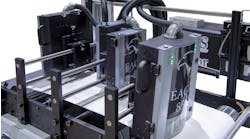Even though 5G is still in its early stages and not rolled out everywhere, analysts are excited about the potential for it to change factories this year.
1. It Will Further Applications of Industrial Robotics
The advantages of 5G, such as increased connectivity and low latency, will encourage factory leaders to implement more pieces of high-tech machinery, like robots. As a result, companies will see the improvements such equipment can bring. For example, some organizations already use collaborative robots—cobots—to assist factory workers with their tasks.
Opportunities also exist for machines to "talk" to each other—despite being hundreds of feet away— while using the 5G network. If that happens, it'll be easier to program the robots to do tasks in sequence, with one responding to the actions another machine takes.
2. It Will Help Factories Optimize Output
Due to options like predictive maintenance, sensors, and industrial automation, factory managers will be able to optimize output while keeping costs down. Some connected machines can recognize the impending failure of a part and alert the responsible parties before a breakdown occurs. 5G can help those alerts arrive more smoothly and reliably, allowing companies to avoid catastrophes that could hinder production.
Plus, 5G will make it easier for organizations to rely on products that assess current production levels and identify bottlenecks or other process issues. The increased knowledge means that factories will stay competitive, able to scale up faster to meet demands without wasting resources.
Today's customers increasingly request high-quality products made without delay. The 5G network can help manufacturers confidently increase the total numbers of items produced.
3. It Will Facilitate Real-Time Data Gathering
Another area of abundant potential for 5G in manufacturing relates to real-time data gathering. A single sensor transmitting data every two seconds would send 43,200 signals each day. Of course, modern factories don't have one sensor—they're more likely to have hundreds or thousands. 5G will enable better processing of all the signals, allowing people to access and analyze them immediately.
The virtual absence of delays in information transmission could lead to improved problem-solving or overall visibility for a manufacturing brand. As a result, issues get noticed quicker instead of escalating. To discover what's possible with the new network, Verizon and Corning have teamed up to install 5G in a factory and investigate how the technology improves data gathering, letting the machines communicate with each other in near real-time. 5G-connected cameras for product inspections and autonomous guided vehicles (AGVs) to facilitate goods transport are examples of smart factory technology in use there.
When managers have insights from 5G equipment, they'll make rapid adjustments when necessary and know what they need to tweak for better performance. Machine-to-machine communication could also eliminate lengthy steps.
4. It Will Improve Video-Based Communications
5G should improve video transmissions so that they feature virtually no lagging or garbled content. Now, when video momentarily pauses due to a poor connection, it hard for people to pay attention. When the problem is severe, people may miss several seconds of live-streamed content.
Thanks to 5G, factory workers can receive live video-based training seamlessly. If they need safety education concerning a new piece of equipment, a 5G connection enables everyone from a department or company to receive the new material simultaneously, even if people watch it from multiple sites.
The technology will also allow decision-makers to see live video demonstrations of equipment they may want to purchase and ask questions. Achieving clearer understandings of how advanced machines work through real-time capability displays could help them feel more confident before making large purchases.
5. It Will Bring Products to the Market Faster
5G connectivity will reduce delays that could slow the time to market for manufactured products.
Showing agility and efficiency in an ever-changing industry could help manufacturing companies thrive compared to competitors who resist the transition.
At a Nokia factory that has 5G connectivity and other advanced technologies, like cloud computing and the Internet of Things (IoT), the products arrive on the market 30 to 50% faster due to facility upgrades.
Automotive brands BMW and Audi are among those testing the improved network to assess how it could positively change existing business practices and shorten production timelines.
If manufacturing brands decide to make the next version of a product from a new material, 5G should facilitate that adjustment more quickly than companies without the technology. Plus, if clients are waiting for the completion of an item's first production run, 5G technologies could give more accurate estimates of when shipments will occur.
6. It Will Highlight the Possibility of Security Threats
The 5G network is like anything else in that it has some negative aspects, one of which relates to security issues. Security should already be a top-of-mind concern for factory executives that use connected equipment. However, leaders should increase their awareness of possible threats associated with 5G.
5G has a larger available attack surface. Moreover, as the excitement about the technology rises, the increase in the number of people using it could make the network appealing to hackers. Some parties are raising the alarm now, warning that people who intend to use 5G must prepare to manage security matters. Member states in the European Union released a report outlining some of their concerns, for example.
There will undoubtedly be security issues that are impossible to predict or plan for until 5G becomes more widely available. Such is the case with any new technology. Even after parties learn about some of the associated risks, more will crop up as people use the network and report their experiences.
IT personnel at factories must remain continually alert. Adequate preparedness for some manufacturers may mean hiring additional security experts. For example, if a company invests in a new piece of connected equipment, increasing the size of the IT team may be the best course of action to avoid future issues.
Benefits Abound With 5G Factories—But Risks Exist
Although 5G will help create the factory of the future, it may bring additional security challenges too.
Companies must stay educated while simultaneously learning about the beneficial ways to use 5G technology in operations. They must also remember that the biggest returns on investment often take time to materialize. There will likely be some degree of trial and error as personnel explore what 5G can do.











